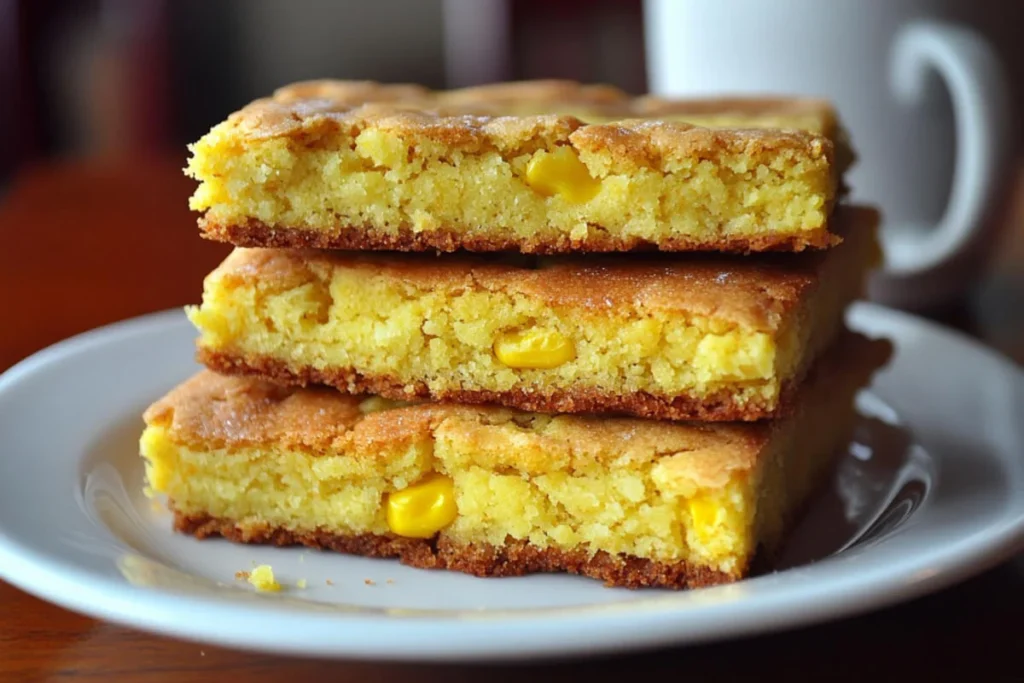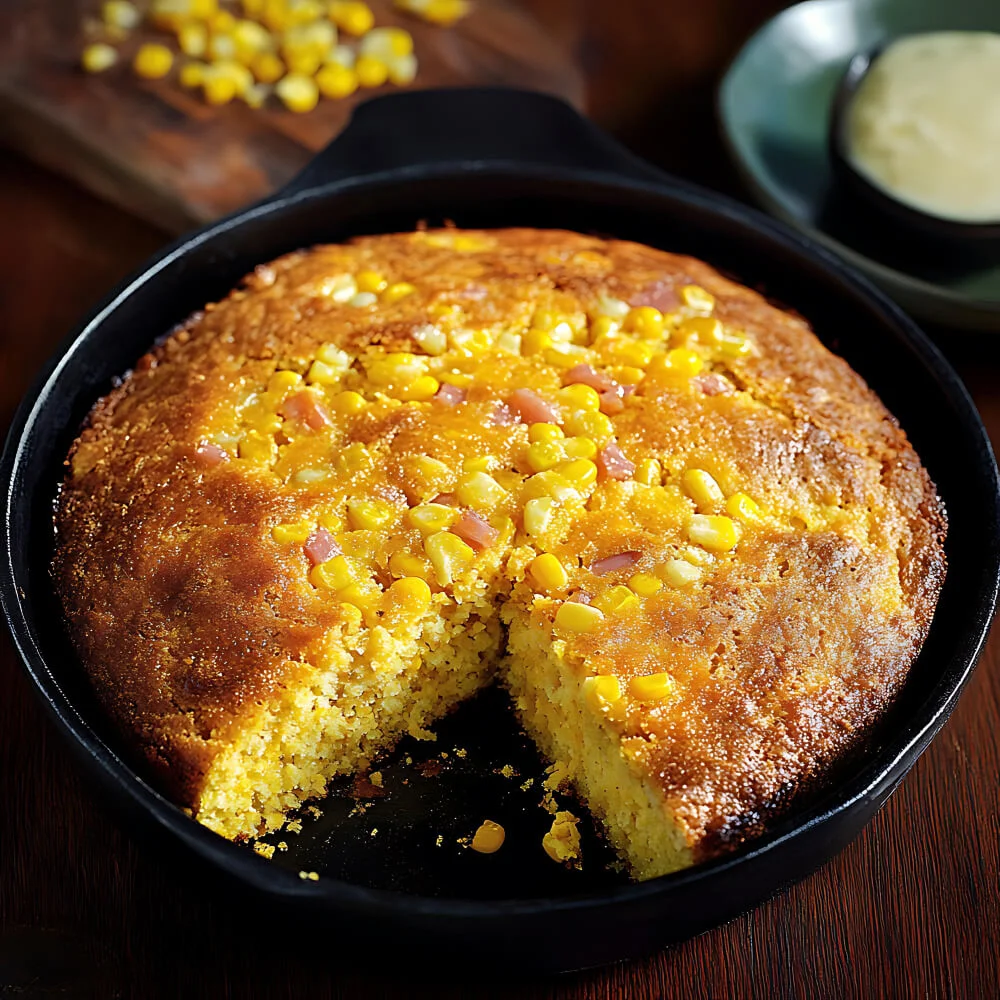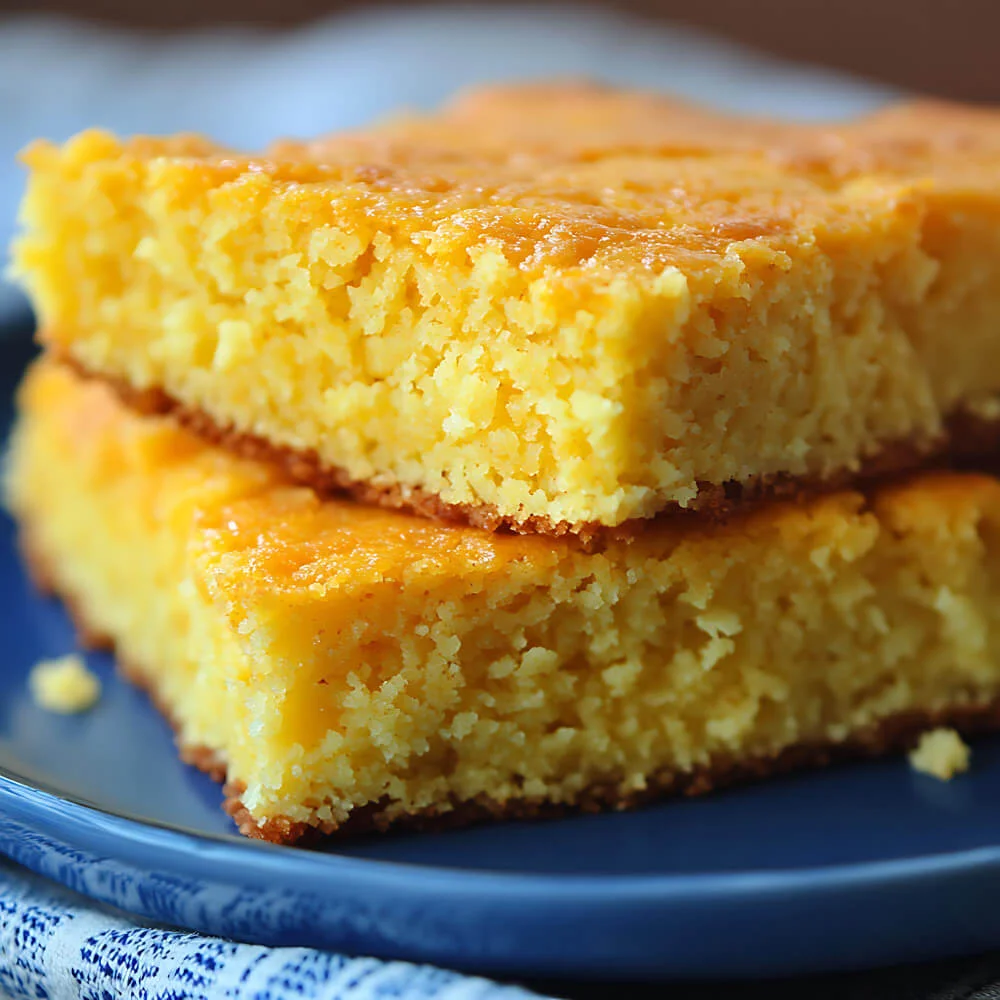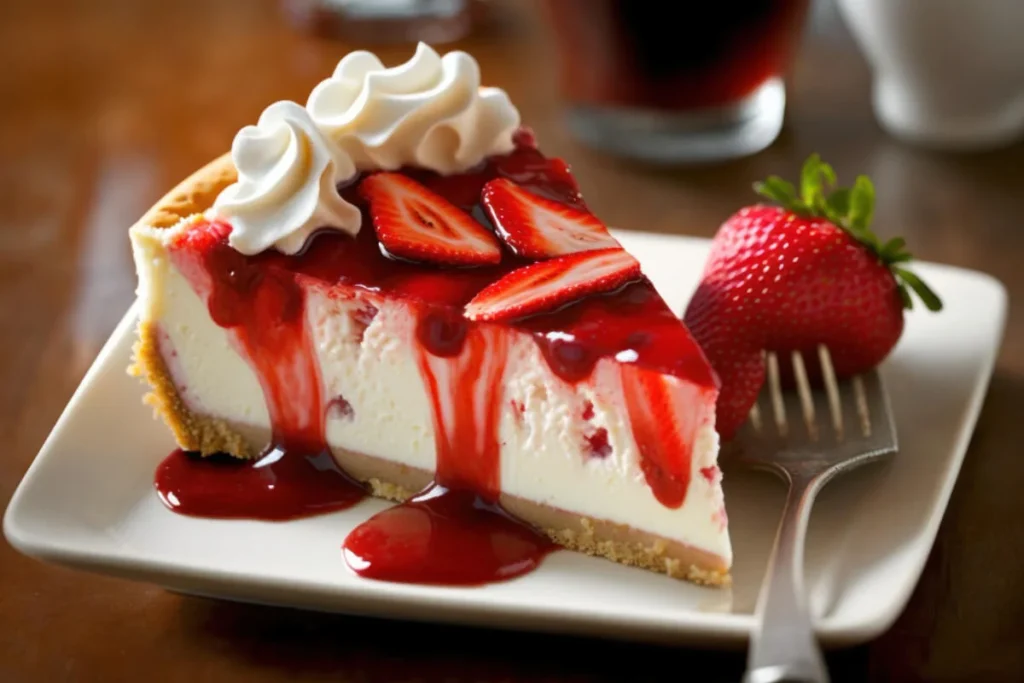
Introduction
The History and Cultural Significance of Southern Cornbread
Southern Cornbread Recipe is a staple of Southern cuisine, deeply rooted in the region’s history and culture. Originally made by Native Americans and later adopted by European settlers, cornbread became a dietary mainstay due to its simplicity and affordability. Over time, it evolved into a beloved side dish, often served alongside staples like fried chicken, collard greens, and barbecue. Southern cornbread is celebrated for its rustic charm and adaptability, reflecting the diverse culinary traditions of the South.
What Makes Southern Cornbread Unique Compared to Other Styles
Unlike its sweeter Northern counterpart, Southern cornbread is traditionally more savory and focuses on the natural flavor of cornmeal. It’s often baked in a cast-iron skillet, which creates a golden, crispy crust. The use of buttermilk and minimal sugar gives it a tangy, hearty flavor, making it a versatile accompaniment to both savory and sweet dishes.
Ingredients for Southern Cornbread
Cornmeal: The Base for Authentic Flavor
Cornmeal is the star ingredient in Southern Cornbread Recipe, providing its signature texture and robust, earthy flavor. Opt for stone-ground cornmeal for the most authentic taste, and choose between white or yellow cornmeal depending on your preference.
Buttermilk for Tanginess
Buttermilk is a traditional ingredient that adds a subtle tanginess and helps create a tender, moist texture. If you don’t have buttermilk on hand, you can make a substitute by mixing 1 tablespoon of vinegar or lemon juice with 1 cup of milk.
Eggs and Fat for Texture and Flavor
- Eggs: Help bind the ingredients and give the cornbread structure.
- Fat: Typically lard, bacon grease, or butter, fat enhances flavor and contributes to the moist texture. Adding a bit of fat to the skillet before baking also helps achieve the iconic crispy crust.
Traditional Southern Cornbread Recipe Variations
Sweet vs. Savory Cornbread: The Great Southern Debate
One of the most debated topics in Southern cooking is whether cornbread should be sweet or savory.
- Savory Cornbread: Traditional Southern cornbread is often made without sugar, letting the natural flavor of the cornmeal shine.
- Sweet Cornbread: Some prefer adding a touch of sugar or honey for a slightly sweet twist. While this style is less traditional in the South, it has its fans.
Adding Mix-Ins Like Jalapeños, Cheese, or Bacon
Southern cornbread is highly adaptable, and mix-ins can elevate its flavor and texture:
- Jalapeños: Add a spicy kick to the cornbread.
- Cheese: Shredded cheddar or pepper jack adds richness and creaminess.
- Bacon: Crispy, crumbled bacon lends a smoky flavor and extra texture.
Tools Needed for Southern Cornbread Recipe
Cast Iron Skillet: The Key to a Crispy Crust
A cast iron skillet is essential for achieving the signature crispy crust of Southern cornbread. Its ability to retain and distribute heat evenly creates a golden, crunchy exterior while keeping the inside tender and moist. Preheating the skillet before adding the batter is crucial to lock in the texture.

Mixing Bowls, Whisks, and Spatulas
- Mixing Bowls: Use separate bowls for dry and wet ingredients to ensure even mixing.
- Whisk: Ideal for combining ingredients without overmixing, which can make the cornbread dense.
- Spatulas: Helpful for folding ingredients together and scraping every bit of batter into the skillet.
Step-by-Step Southern Cornbread Recipe
Preheating the Skillet for a Golden Crust
- Place the cast iron skillet in the oven and preheat to 425°F (220°C).
- Add a tablespoon of butter, lard, or bacon grease to the skillet while preheating, allowing it to melt and coat the bottom evenly.
Mixing Dry and Wet Ingredients Separately
- Dry Ingredients: In a large bowl, combine 1 cup of cornmeal, 1/2 cup of all-purpose flour, 1 teaspoon of baking powder, 1/2 teaspoon of baking soda, and a pinch of salt.
- Wet Ingredients: In a separate bowl, whisk together 1 cup of buttermilk, 1 large egg, and 2 tablespoons of melted butter or oil.
- Combine: Gradually add the wet ingredients to the dry ingredients, mixing just until combined. Avoid overmixing to keep the texture light and tender.
Cooking Southern Cornbread
Baking Tips for an Even Texture
- Pour the batter into the preheated skillet, ensuring it spreads evenly. The hot skillet will immediately start forming a crispy crust.
- Bake in the oven for 20–25 minutes or until the top is golden brown.
How to Know When Your Cornbread Is Done
- Visual Cues: The edges should pull slightly away from the skillet, and the top should be golden and firm.
- Toothpick Test: Insert a toothpick into the center of the cornbread. If it comes out clean or with a few crumbs, it’s ready.
Tips for Perfect Southern Cornbread
Achieving a Crispy Crust with a Hot Skillet
- Preheat the Skillet: Always preheat the skillet in the oven with a small amount of fat (butter, lard, or bacon grease) before adding the batter. This ensures an instant sizzle, which forms the iconic crispy crust.
- Don’t Skip the Fat: Adding fat to the skillet not only enhances flavor but also prevents the cornbread from sticking.
Avoiding a Dry or Crumbly Texture
- Don’t Overbake: Remove the cornbread as soon as a toothpick comes out clean. Overbaking can dry it out.
- Use Buttermilk: The acidity in buttermilk tenderizes the cornbread, keeping it moist and flavorful.
- Avoid Overmixing: Stir the batter just until combined to maintain a light texture.
Serving Suggestions
Pairing Cornbread with Classic Southern Dishes
Cornbread is a versatile side that pairs beautifully with hearty Southern staples:
- Chili: The cornbread’s slight sweetness complements the spicy, savory flavors of chili.
- Greens: Serve with collard or mustard greens for a traditional pairing.
- Fried Chicken: Cornbread adds a comforting, carby element to balance the crispy, juicy chicken.
Serving with Butter or Honey for Added Flavor
- Spread warm cornbread with salted butter for a simple, savory enhancement.
- Drizzle honey over the top for a sweet finish, perfect as a snack or dessert.
- Add flavored butter, like honey-cinnamon or herb-infused, for a gourmet touch.
Making Cornbread for Special Diets
Gluten-Free Southern Cornbread Using Alternative Flours
- Replace all-purpose flour with almond flour, rice flour, or a gluten-free flour blend.
- Use certified gluten-free cornmeal to ensure no cross-contamination.
Vegan Substitutions for Buttermilk and Eggs
- Buttermilk Substitute: Mix 1 cup of plant-based milk (like almond or soy milk) with 1 tablespoon of vinegar or lemon juice. Let it sit for 5 minutes to curdle.
- Egg Substitute: Use flaxseed meal mixed with water (1 tablespoon flaxseed meal + 2.5 tablespoons water per egg) or a commercial egg replacer.
Storing and Reheating Cornbread
How to Store Cornbread to Maintain Its Freshness
- Room Temperature: Store cornbread in an airtight container or wrapped tightly in plastic wrap for up to 2 days. Keep it in a cool, dry place to prevent it from drying out.
- Refrigeration: Extend freshness by storing in the refrigerator for up to 5 days. Place in an airtight container to retain moisture.
- Freezing: Wrap individual portions in plastic wrap and place them in a freezer-safe bag. Cornbread can be frozen for up to 3 months. Thaw at room temperature or in the refrigerator overnight.
Reheating Tips to Preserve Texture
- Oven: Preheat the oven to 350°F (175°C). Wrap the cornbread in aluminum foil and heat for 10–15 minutes to keep it moist.
- Microwave: Heat individual portions on medium power for 20–30 seconds. Cover with a damp paper towel to retain moisture.
- Skillet: Warm cornbread slices in a lightly buttered skillet over low heat for a crispy exterior.
Cornbread Leftover Ideas
Using Leftovers in Cornbread Stuffing or Croutons
- Cornbread Stuffing: Crumble leftover cornbread and mix with sautéed onions, celery, broth, and seasonings. Bake until golden for a delicious stuffing.
- Croutons: Cut cornbread into cubes, toss with olive oil and seasonings, and bake at 375°F (190°C) until crispy. Perfect for topping salads or soups.

Making Cornbread Salad or Cornbread Pudding
- Cornbread Salad: Layer crumbled cornbread with chopped vegetables, beans, shredded cheese, and a tangy dressing for a hearty salad.
- Cornbread Pudding: Combine crumbled cornbread with milk, eggs, sugar, and spices, then bake for a sweet and creamy dessert.
Nutritional Information
Calories and Macronutrients Per Serving
A typical serving of Southern cornbread (1 slice or 1/8 of a 9-inch skillet) contains:
- Calories: 150–200
- Fat: 7–9 grams (varies by type of fat used)
- Carbohydrates: 20–25 grams
- Protein: 3–5 grams
Healthier Adaptations with Whole Grain Cornmeal
- Whole Grain Cornmeal: Use stone-ground or whole grain cornmeal to increase fiber and nutrients.
- Reduce Fat: Substitute butter with unsweetened applesauce or Greek yogurt for a lighter version.
- Lower Sugar: Use less sugar or natural sweeteners like honey or maple syrup to reduce added sugars.
Common Mistakes to Avoid
Overmixing the Batter Leading to Tough Texture
- Why It Happens: Overmixing activates the gluten in the flour, resulting in a dense and tough texture rather than the light and tender crumb Southern Cornbread Recipe is known for.
- How to Avoid: Stir the wet and dry ingredients together just until combined. A few small lumps in the batter are fine and will not affect the final product.
Skipping the Preheated Skillet for the Crust
- Why It Matters: A hot skillet is essential for achieving the iconic crispy crust that sets Southern cornbread apart. Without it, the cornbread may stick to the pan and lack the golden, crunchy exterior.
- How to Avoid: Place the skillet in the oven while it preheats, adding a bit of fat (like butter or bacon grease) to heat along with it. Pour the batter into the hot skillet, which will sizzle on contact and begin forming the crust immediately.
Frequently Asked Questions
Can I Use Regular Milk Instead of Buttermilk?
Yes, you can use regular milk instead of buttermilk, but it may alter the flavor and texture slightly. To mimic the tanginess of buttermilk, add 1 tablespoon of vinegar or lemon juice to 1 cup of milk and let it sit for 5 minutes before using.
What’s the Difference Between Yellow and White Cornmeal?
The primary difference is the type of corn used:
- Yellow Cornmeal: Made from yellow corn, it has a slightly sweeter and richer flavor.
- White Cornmeal: Made from white corn, it has a milder, more neutral flavor. Both can be used for cornbread, depending on your taste preference.
What Is the Difference Between Cornbread and Southern Cornbread?
Southern Cornbread Recipe is traditionally more savory, focusing on the natural flavor of the cornmeal, and often made without sugar. It’s usually baked in a cast iron skillet for a crispy crust. Other styles, like Northern cornbread, tend to be sweeter and cake-like, with a softer texture.
Why Do Southerners Not Put Sugar in Cornbread?
Sugar is not traditionally added to Southern cornbread because the dish was historically a savory staple, meant to accompany other savory meals. The natural sweetness of the cornmeal was enough. Some southerners still hold to this tradition, while others enjoy adding a touch of sugar for personal taste.
Is It Better to Use Buttermilk or Milk in Cornbread?
Buttermilk is preferred for its tangy flavor and tenderizing effect on the cornbread, creating a moist and flavorful texture. Regular milk can be used as a substitute, but the cornbread may lack the depth of flavor that buttermilk provides.
What Do They Call Cornbread in the South?
In the South, cornbread is simply called “cornbread,” but there are regional variations like “hoecakes” (fried cornbread) or “Johnnycakes” (a flatter version of cornbread made on a griddle). Each variation reflects the unique culinary traditions of different Southern regions.
Conclusion
Southern cornbread holds a special place in the heart of Southern cuisine and culture. Its simplicity, versatility, and signature crispy crust make it a beloved side dish that pairs beautifully with a variety of meals. From its rustic roots to modern variations, Southern cornbread continues to be a staple at family dinners, barbecues, and holiday feasts, celebrated for its ability to complement both sweet and savory dishes.
Southern cornbread is a cherished staple with a rich history rooted in Southern cuisine. Known for its golden crust and savory flavor, it’s traditionally baked in a cast iron skillet to achieve its signature texture. Whether you prefer a classic recipe or enjoy experimenting with variations like adding jalapeños or cheese, cornbread is a versatile side dish that pairs perfectly with Southern classics like chili or collard greens. Explore more recipes for authentic Southern dishes and creative adaptations on Org Recipes. Would you like additional tips or specific recipes to perfect your Southern cornbread?
Making Southern cornbread at home is a rewarding experience that allows you to savor its authentic flavor and texture. Whether you stick to a traditional recipe or experiment with mix-ins like jalapeños, cheese, or bacon, the possibilities are endless. Don’t forget to preheat your cast iron skillet for that iconic golden crust! With just a few simple ingredients, you can create a timeless dish that brings warmth and comfort to any meal.
Viral Tuna Salad: 5 Bold Reasons Matthew McConaughey’s Recipe Wins
Healthy Homemade Chicken Mortadella
Chicken Mortadella changed my deli game forever. I used to stare at processed meat…
The BEST Taco Pasta
When I’m short on time and need to get a satisfying dinner on…
Classic German Kartoffelpuffer Recipe (Authentic, Crispy & Easy to Make)
Easy Butter Pecan Cookies Recipe
There’s something undeniably comforting about the scent of buttery, nutty cookies wafting from…
Perfect Strawberry Cheesecake Recipe
If there’s one dessert that’s guaranteed to silence a lively room, it’s this…







1 thought on “Southern Cornbread Recipe”